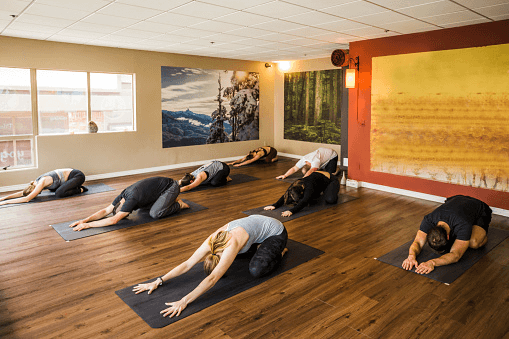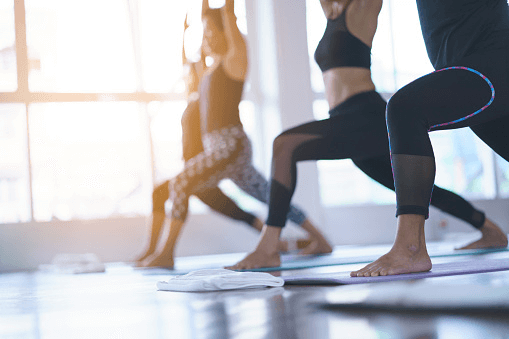How to Avoid Getting Sweaty During Yoga Class

Yoga is now a full part of our society, we've all done some here or there, casually or even professionally. There are many different ways of practicing it, and none are necessarily more right than others. There are a few things that all yogis can agree on though, and one of the very worst is when you're getting into your practice and you just start to sweat profusely and have to wipe the drops off of your forehead and clothes and mat and hair! What a mess. Even if you do catch the cheeky little droplets, and they get on your mat, you're just more likely to slip on them and potentially injure yourself. Even if you regain your balance, your flow will have been interrupted, and this is a problem that is likely to repeat itself. As such, it is best to be dealt with at the source. Just avoid sweating! Easier said than done, you say? Not if you put your mind to it – there are plenty of different ways to prevent and minimize the amount of sweat we produce, and here we will suggest just a few for you to get started with.
Stay In
Some ancient yogi texts take the no-sweat rule so seriously, they recommend staying out of the sun, and to avoid being near the fire when practicing. They believed that sweating would lead you to lose energy known as Ojas, and even recommended rubbing your sweat back in to preserve any energy you might have lost! Now, to avoid having to do that, just stay indoors, or in the shade.
Non-Slip Mats
Always there for us, micro and nanomaterials allow for fantastic properties when it comes to friction and water resistance. There is a wide range of yoga mats that won't let you down – literally – and quite a range in quality as well. Keep in mind that there won't always be a correlation between quality and price, so do ask friends and check for reviews before investing in one. A high-quality slip-resistant mat will help you keep your practice comfortable and safe, and most of all, uninterrupted.
Use Starch Or Kaolin Clay On Your Hands And Feet
In the olden days, we would have suggested talcum powder, but the smell isn't particularly attractive and it actually is a carcinogen. So, instead, use rice, corn, or tapioca starch, which will have similar properties, or kaolin clay, which is used in many cosmetics and face masks and has the water-absorbent properties of clay.
Try Some Different Clothes
Traditionally, yoga would have been practiced with minimal to light clothing on, clothing that would not weigh on your movement or get in the way of your movement. Today, we dress differently, and many of us don't necessarily have the right clothes at home to take to a class and stretch our booty in. If this is your case, you might want to try these hot yoga pants, which are designed to keep your body cool and dry. Having the right fit and the right material is essential to choosing the right clothing for any physical activity, and you can always go for a look that combines function and aesthetic.
Get Some Air Flowing
Not too much, but you get the idea. A soft, cool breeze, that carries the scents of the trees. Ideally. If you live on the ground floor, next to a bus stop, maybe you want to stick to a fan and your choice of essential oils, but nothing that would be overpowering or distracting. This can be a great way to ease into your flow, and there are oils like eucalyptus, ravinsara, or peppermint, which can help you cool down inside out without anything changing in your external environment.
Avoid Drinking Anything Hot
Quite obviously, this will raise your body temperature at the very core, and every movement you make will then circulate that heat throughout your body. This is highly undesirable if you are trying not to perspire. Limit your consumption of hot fluids in the hours that precede your yoga session, so that your body temperature stays in tune with your surroundings. If there is anything you like to have hot – perhaps prepare it before, and refrigerate it, to have it cold.
But Do Drink Something Cold
You won't sweat more if you drink more. You might just be more likely to need to go to the bathroom. Cucumber-infused water will not only keep your cells happy and plump, but it will also give them the electrolytes they need to stay in a balanced state of hydration and keep your energy flowing through them and through your body. You can also add other things to your water, it doesn't just have to be a cucumber. The key with hydration is to do it regularly – if you've been drinking well all week and all day, you'll be fine. If you drink a liter just before you start, maybe not the best yoga you'll do.

Do not bring down the ire of the ancients upon yourself, and do not let a drop of sweat so much as a bead on your forehead, or you shall be doomed. Jokes. But seriously, there's a lot you can do to mitigate the sweaty-messy-slippery situations that will inevitably arise during your own yoga journey. Over time, you will learn how your body works, and your body will learn how you work, and you will see yourselves adapting to each other if that makes sense. You are the same person after all, but our minds tend to forget about our bodies, who in turn stop talking back as much. Yoga is all about balance and energy, and sweat is just a waste product of our efforts. In theory, if you reach perfect effectiveness and efficiency in movement, flow, and balance of water and energy, then there should be no byproduct – no sweat. If a drop or two gets away from you, ignore them, or it will just make you sweat more!
839GYLCCC1992



Leave a Reply